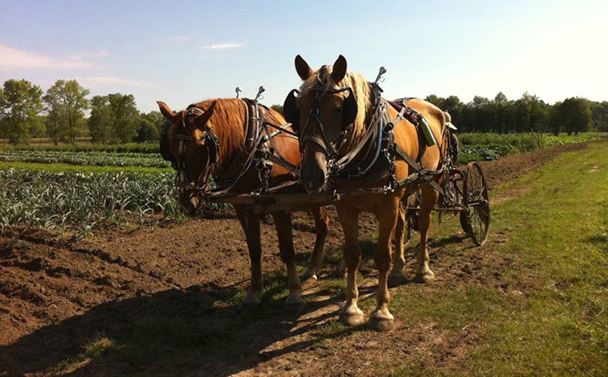Our farm, on the easternmost edge of northern New York, produces a full diet, year–round, for 170 people. These members sign up with our CSA for the year and come to the farm once a week to pick up their share of what we’ve raised or grown, including beef, pork, chicken, eggs, milk, vegetables, grains, dry beans, fruit, and maple syrup. It’s a joy to feed such a big farm family, but also a heavy responsibility. In our community, most people can’t afford a membership here while also footing the bill at the supermarket, so it’s up to us to fill their bellies. We got a record–breaking amount of rain over the past few months, about three times what’s normal. Lake Champlain, a mile away, spent more than nine weeks above flood stage, and crested a foot above the highest known flood level. As old farmers around here will tell you, a dry year will scare you, but a wet one can starve you.
The growth of the slow food and locavore movements means it is common now to speak of terroir in the context of not only grapes and wine but also milk, meat, grains, and vegetables. Hear, hear. What ends up on a fork is indeed a reflection of a particular time and place. But the unspoken assumption is that choosing local food, and knowing its history, is a more sophisticated and delicious choice than commodified anonymous food. The truth is, farming is a chess game with a zillion possible variables, not all of them under the farmer’s control. On small acreage, using organic methods, the outcome is even less predictable. You can taste an unforgettably bad spring, as well as a particularly good one. If you were to describe the essential character of our part of the world right now, it would be bracingly chill and overwhelmingly wet, with a hectic finish.
With only 100 days between frosts, our growing season depends largely on getting grains and vegetables planted on time. You can’t plant when the soil is saturated. We do our field work with draft horses instead of tractors, but hooves sink just as tires do. Working wet ground compacts the soil, crushing vital air spaces. If you somehow manage to get fields prepared and plants in the ground, cold and wet conditions can stunt or rot them. We lost a whole planting of potatoes that way this year, and our first round of tomatoes, plus spring peas, spinach, and half the winter wheat. If the poor plants survive wet feet, they face further difficulties: Weeds have the jump on them, because the horse–drawn cultivator can’t do its work. And all that rain tends to wash nutrients out of the ground, leaving the crops weak, vulnerable to disease and marauding insects.
So what does a wet year taste like? Lucky for us, a highly diversified farm system is also pretty resilient. We have been eating from this land for eight years, and I’ve yet to go hungry or get bored in the kitchen, even in a shockingly bad year like this one. Spring vegetables are a shambles right now, but the cows are milking beautifully on all this lush grass; we have plenty of meat, stored supplies of grains and beans, fabulous eggs, plus the hardiest of our root crops from last fall. Not to say that what we are eating would be a hedonist’s first choice. The root cellar is getting low, and some of the standbys—carrots, onions—have gone limp and tasteless. But rutabaga, like cockroach, survives anything. I usually find cooking with them just about as appealing.
The rutabagas we grew last year are the size of my head and still hard as rocks. They have been the great hulking wallflowers of the cellar this year, waiting for someone to want them. Faced with a hungry family and no fresh produce a few weeks ago, I hauled one upstairs to the kitchen and broke it down to primal cuts with my biggest butcher knife. It had been so long since I’d cooked one, I’d forgotten that the color of its flesh is beautiful, a light shade of mango. I grabbed the box grater and began to shred, which put me in mind of latkes. I added eggs, buttermilk, some flour, salt, and baking soda, and then a big handful of chopped scallions, and we were suddenly moving away from Odessa and toward Osaka, landing somewhere in the middle: rutabaga–scallion pancakes, served with soy–ginger dipping sauce. They were a big hit. That particular combination would never have graced our table if I had the usual June fare available.
Something similar happened with the dry beans, and with the oats—two ingredients that are always available, and therefore seldom celebrated. I made hummus out of the cranberry beans, and maple–sweetened granola with the oats. Wild nettles harvested from the pasture provided some much–needed greenery. Then the asparagus made its long–delayed debut, and the rhubarb, and a few scrappy heads of lettuce that survived the flood, and the world of my kitchen felt new again. Turns out that the taste of a disastrous year is inventive, and full of anticipation.
It has stopped raining, and a week of long sun–soaked days has turned the fields from muck to perfectly workable. Now everything is a rush. We have two weeks to plant the 25 acres of grain and 16 acres of vegetables we’ll need to feed the stock and the people through the winter. There is hay to be made on the rest of our 500 acres—10,000 bales this season, and the first cutting is already late. But first we have to kill the weeds that have proliferated, after all these weeks of wet. All of us—horses, humans—are working now with a keen sense of urgency, for as long as daylight permits.



 Pinterest
Pinterest


